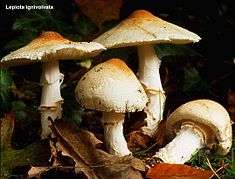Lepiota ignivolvata
| Lepiota ignivolvata | |
|---|---|
 | |
| Rare / British Red Data List | |
| Scientific classification | |
| Kingdom: | Fungi |
| Subkingdom: | Dikarya |
| Division: | Basidiomycota |
| Class: | Agaricomycetes |
| Order: | Agaricales |
| Family: | Agaricaceae |
| Genus: | Lepiota |
| Species: | L. ignivolvata |
| Binomial name | |
| Lepiota ignivolvata Bousset & Joss. | |
| Lepiota ignivolvata | |
|---|---|
|
| |
| gills on hymenium | |
|
cap is convex or umbonate | |
| hymenium is free | |
| stipe has a ring | |
| spore print is white | |
| edibility: inedible | |
Lepiota ignivolvata, sometimes known commonly as the Orange-girdled Parasol, is a rare member of the Lepiota genus of gilled mushrooms.[1] It is among the larger species in this group, growing in coniferous or deciduous woodland during autumn; it has a primarily European distribution. Being inedible, and perhaps poisonous, it should not be gathered for culinary use. Many of the species in this genus are deadly.
Description
The cap is between 4 to 10 centimetres (1.6 to 3.9 in) in diameter. It is convex, later flat, and with a raised central boss (umbo). The centre of the cap is reddish brown, or orange-brown, breaking into small scales, which are fewer, and lighter towards the margin.[1] The best identification aid is the orange (somewhat indented) ring, which is low on the white, slightly bulbous to club-shaped stem,[2] which often has an orange flush at its base. The gills are white to cream, giving a white spore print.[1] They are free of the stem, and are fairly crowded together. The flesh is white throughout, and has an unpleasant chemical smell, similar to that which is produced when cutting metal;[2] the odor has also been compared to rubber.[3] L. ignivolvata has an unpleasant, rancid taste.[3] The spores are spindle (fusiform) or almond (amygdaloid) in shape, with dimensions of 9–13 to 5–7; µm.[3]
The similar species Lepiota ventriosospora and Lepiota cristata lack the orange colouring on the ring.
Distribution and habitat
Lepiota ignivolvata is widespread across Europe, its stronghold being in central to southern Europe.[2] In Britain it is rare, and resides on the British Red Data list. It appears in deciduous, and coniferous woods, in autumn, and seems to favour beech.